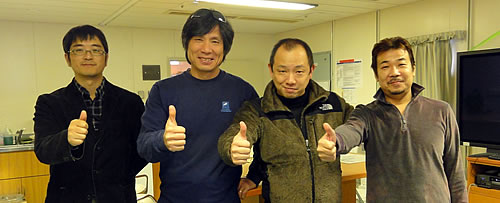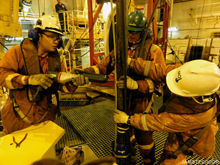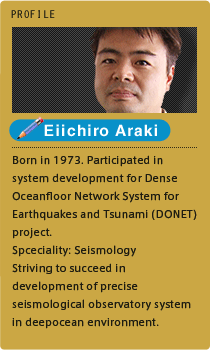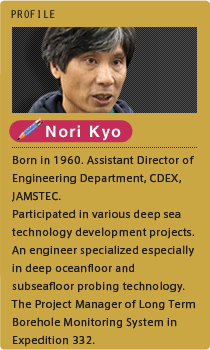

The Final Chapter “The Drifters’ Destination”2010.12.13
I know I had written “Chapter 1.” last time on this report, but today’s report is the final one. (“WHAT!?” By the publishers...)。
Anyhow, fully-assembled LTBMS (still a temporary name... Dr. Araki, make it official, please!) had to go hanging for about 20 miles to the installation site.
Why hang the sensor for such a long distance? Because, the currents at the installation site are quite strong and assembling such a sensitive sensor like LTBMS can be under great risk of possible damages caused by Kuroshio. So, what we did was to assemble the system where the currents were calm, and kind of “surf” on the current or the flow, and approach the installation site, literally by drifting.
We call this technique of approaching to the site by drifting “The Drifters”. The Drifters’ specialists are Sawada-san and Saru-chan. They have successfully done many operations using this technique in this area where it is affected by strong current. They are the true professionals. Lowering the system where the current is mild, drifting away and approaching to the installation site, and install it in a small borehole 2,000 m from Chikyu... Does it all sound very difficult? This is definitely a highly specialised task, which only a limited number of people can make it. In our mission this time, how we succeeded in “The Drifters” technique was the key. The following is how we worked it out!
We must not rush. We must be ultra-super-patiently slow. The speed we “drift” is as slow as a 100-year-old grandfather walking. The distance we need to drift is over 35 km. Surely, it takes a long, very long time. We take about two days for this drift. However, we must not rush. This is a sacred rule for the sake of our success in this mission!
Drifters” has a reliable supporter. His name is “The Rope Boy”! Yes, there is “The METABO Boy”, and now, it is the Rope Boy’s turn. Both METABO and Rope are official supporters of LTBMS. Anyhow, The Rope Boy’s mission is to stop the pipe from oscillating. As we drift, it can alleviate some of the relative convection, however, we are still located in the main street of Kuroshio Town here in Kumano-nada! The current around here is indeed, very powerful. We can’t play with Kuroshio. It is actually hard to imagine when you look at these firm, metallic drill pipes, however, when many of these are connected for 2,000 m down to the seafloor and put within a strong current, they start to oscillate so badly. We don’t want that to happen, and the Rope Boy helps us greatly! Just run the rope along the drill pipe, tie it with a band. It is amazing how this mere act of tying a rope along the pipe stops the oscillation! I can not forget the excited face of Saru-chan when he turned and shouted at me, saying “This rope works!” (Sorry, Saru-chan, but I could not believe even half of what you were telling me about back then.)
That was the beginning of my friendship with the rope, and now I am an eager rope collector! And so, Sara Chan has gathered all the ropes on Chikyu... literally uncountable numbers of ropes are piled up here!
Thanks to these ropes, LTBMS could reach that entry cone without oscillating but standing ramrod straight.

The Drifters operation members just before leaving Chikyu
Let me write a little more, for this is the final chapter of Chikyu Report. After the arrival at the re-entry cone, the LTBMS completed the sensor operation check, and finally went into that narrow borehole. We were all so excited, and also worried. The LTBMS staff all gathered in front of the large-screen monitors, sat still, ad waited for the moment of those critical images to be sent to us by ROV. The 3-1/2” tubing suddenly started to look thinner, the cable loose, the packer swollen... but no, these negative images were just our illusion. We said, “let’s just trust in our struggles we’ve made so far!” and the moment began in a very smooth movement. We saw each part of LTBMS’ body, the bull nose, mini screen, centraliser, strain meter, sensor carrier, disappearing into the borehole in that dark and silent deep sea. After the “strong current hell”, the “abrasion shock hell” awaited the LTBMS, however, it successfully went into the borehole, checked, got cemented, drill pipe cut off. All were well done. Thus the entire installation was completed.
04:01, 9th of December 2010.
LTBMS... He is smiling down there below the seafloor, standing firm against the current, shock from the drill head and abrasion within the casing. Never failing in all functions, staying in the borehole neatly. We will come to see you again next year in March by HYPER-DOLPHIN...!

His smile awaits us at Site C0002!
Nori KYO


Chapter 1. “Landing on the water”2010.12.7
19:50, 5th of December 2010. Today is the 42nd day since the cruise has begun. At last, Long Term Borehole Monitoring System (still a tentative name) has landed on the water. Upon LTBMS’s departure to the C0002 drilling site, we dads could not do much but to lean on the handrails at moonpool to say “Good luck, boy! All the best on the way to C0002! Never let the current overtake you!” (You notice that we think LTBMS is a boy.) However, I admit that the past nine days have been extremely troublesome. I felt it lasted forever. In an exaggerated term, it was the “birth pang”. Does it sound too dramatic?
I know people want to read something “exciting”, but I am rather attracted to more quiet, steady and honest things.
Therefore, today, I would like to introduce the METABO boy. No, not you who is reading this and is worried of your metabolic syndrome! It is a stainless band-fastening tool called “The METABO” produced by a certain famous manufacturer.
As I explained before, we have to run cables along the 3-1/2 inch (9 cm) tubings that measure 1,000 m long, and it becomes critical if the cables get damaged while running down within the 8-1/2 inch (21 cm) internal diameter borehole.
Thus, it is needless to say they need to be tightly bundled. This may sound so basic, but the basic is what matters the most here.
The METABO boy is one of our strategies to counter with possible accidents and mishaps.
He (the METABO boy) has got on board from Shimizu Port with quiet but clearly audible rumours going around him, saying “Hey, did you hear about him? Is it true that he can easily tie up all the stainless bands at once!?” and “Oh, yes…! He sounds like a great guy…!”
So, how does he look like? Hmm…, he is quite attractive. He comes with an ebony-black portable case, and when you open it, there he is. The METABO boy looks stunning, like a Kalashnikov.
I think that any boy would want to hold him up and have him at ready.
Anyhow, on the night before the real thing, we decided to have a light warm-up, and had an operating check under the supervision of A.C. instructor but something was wrong.
The boy could not really bundle the stainless bands.
After a while, there were piles of stainless bands that could not be successfully tied up.
We struggled, cheated and pacified, and finally the real operation had to be done the following day.
The boy could not perform well despite everyone’s faint hope. Sad. In addition, our pre-cruise plans depended a lot on this boy and we brought more stainless bands, so the problem came onto our shoulders now.
An emergency top-level meeting was held. They decided to halve the number of stainless bands for faster operation, but they knew it was still too slow… They were distressed, thinking of how to cope with this situation, and at one moment, someone saw the large screen in the office showing what was going on at the moonpool. Next moment, they all got shocked!
The METABO boy was working at his full speed!
It had been slow and troublesome as if he were working and complaining “Hmm… Oh, don’t really like this bit. Oops, dropped it! Okay, one more time…” And now, he was much faster, probably he was working and saying “Got it! Tied and fixed. Come on, next, please!”
The scientists were so amazed and asked who were operating the boy. JOYCEN-kun and JASON-kun? What great operators we have got on board!
The problem was that we had not fully understood how to operate the METABO boy!
The superior drilling crew team members of Chikyu have quickly mastered the operation method of the METABO boy, and the operation is now going at the speed ten times faster than before! We can not thank them enough.

“Got it! Tied and fixed. Come on, next, please!”
I guess by now my report is beginning to annoy those top-level people on the land, but please consider my situation; when we get stressed, that is exactly when we need some laughs.
Right now, the LTBMS is heading to the direction where the current is stronger.
The ROV is already in the location where the current is strong and is taking the rope from the LTBMS.
The long Chapter 1 is finishing, and continuing to Chapter 2, “Into the Current”.
Nori KYO


[Set Sail]2010.11.29
20:00, 27th of November 2010. Set sail for C0002 Drilling Site from Shimizu Port… However, before the departure there was a three-days struggling for several members of LTBMS Team, trying to reel up the sensor cable at Shimizu Port. The sensor cable is as important as the nerves and blood vessels are for a human body. It means that if the sensor cable gets broken, the whole system just collapses. I hope you now know how important the cable is. In our actual operation procedure, we run this precious cable along 3-1/2 inch tube within 9-5/8 inch casing, letting it out for 1,000 m. You can imagine how cautiously we need to do that! So, why did we have to struggle reeling up the sensor cable? It was the winch we rented that had some trouble. There were four winches, and two went wrong. Guess how sad we were. I did not really expect such a trouble right before the departure. Some people might ask us “Oh, but you rented them, right? Why don’t you just ask them to fetch good ones as replacements?” But we rented them from Singapore, and we had only four days left for our departure. The only choice we had was to fix them by any means. But the winches were old and there were no replacement parts. At some point, we felt as if were on a deserted island trying to survive although we were in town. Oh, but in the end, the LTBMS Team made it…!
We disassembled the motors and valves, cleaned, polished and assembled them up again, and repeated these many times patiently although we experienced occasional depression attacks. In the end, we made all the winches work correctly on time before the departure! Even the worst winch #9803 that was making some noise of a diesel engine recovered and began reeling up smoothly.
I would like to thank the great members of LTBMS Team who cleared the “Shimizu Port Mission”; SARU-chan, Kashiwase, Kimura-kun, Namba-chan, and Fujiken-san from the Logistics Team for their support and effort. By the way, Kimura-kun… you really look as if you were on a “survival trip” with your beard! If your beard keeps growing at this speed, I think your beard and hair will all cover up your face and head at the end of the LTBMS installation. Anyways, your beard issue will be a funny update during the expedition.
When Chikyu departed Shingu Port, Mt. Fuji was covered in snow only on the top northern side. Now, as we are leaving Shimizu Port, it is totally covered in snow and looking majestic. I felt Mt. Fuji pushing my back telling, “Now, go. And good luck!” Yes, we are now heading to C0002 Drilling Site once again.
Nori KYO


SmartPlug & GENIUSPlug2010.11.16
So, what we did first right after escaping from a typhoon was retrieving an observation equipment from the borehole C0010A. This site was where we drilled last year on our Expedition 319. We had installed an observation equipment called SmartPlug for measuring temperature and pressure.
You would probably like to know what SmartPlug is like? Usually, we place a plug in the borehole after drilling it, and SmartPlug is a smart version of such a plug with a logger to keep records of temperature and pressure. Literally, it is not just a mere plug, but is smart with a logger, thus we named it “SmartPlug”. In Expedition 332, we were supposed to be retrieving the SmartPlug from last year and to place a new SmartPlug, but we got a little more greedy; our updated version of the SmartPlug can record temperature, pressure and even comes with a water sampler! Isn’t it a little more than being “smart”? We thought it was a “genius” plug! It is very simple, actually. (I’m not talking about the plug’s functional capabilities, but our way of naming equipment etc., haha…) You might want to warn us we would probably run out of better names when we update and improve this GENIUSPlug in the future, but anyway, we will think about this problem later!
Well, the name of the plug may sound slightly cheesy, however, we are paying extreme attention while installing the GENIUSPlug and retrieving the SmartPlug. The site C0010A is located in where Kuroshio current is running at 10 m/sec. Therefore, if we carelessly lowered the drill pipe for retrieving, it would cause tremendous wave swings, promising us a failure. Since we faced this “Kuroshio Swings” problem, we have been working on our new development to improve the system. As a result, we did find a way to quietly lower the drill pipe without being affected by swings and vibrations caused by Kuroshio, and to retrieve the equipment safely.
Yet, the operation of retrieving and installation made us very nervous. When we succeeded in retrieving the SmartPlug, we were so happy and excited that we almost jumpied up and down like a child! I am greatly thankful to all the crews on Chikyu.
Now that we have succeeded in GENIUSPlug installation, we are moving on to the next mission of drilling a borehole for installing Long Term Borehole System.
Eiichiro Araki


[My current state of mind]2010.11.15
15:45, 27th of October 2010.
I watched after the brave, retreating figure of Chikyu leaving Shingu Port under the cloudy sky. I know people would say whether Chikyu looked brave or else depends on the person or the person's mood who watched her leave. But you know, she looked just inevitably brave to my eyes. I think Namba-chan who was standing next to me also found her looking "brave", too. Why? Because the expedition to install Long Term Borehole Monitoring System has actually begun.
Looking back, I remember myself joining the late Dr. Fred Spies' team at the Ocean Seismic Network (OSN) site in Hawaii to install seismometer in the borehole, back in 1998. Since then, I have been participating in JAMSTEC's borehole observatory system engineering development. But, well, have I been responsible for their installing operations since then? Actually, no! It just kept remaining as one of the plans on our budget scheme. And what happened at the beginning of this year? All of a sudden, our captain told me, "Hey, you! You're going to do this, yes!? Of course, yes, right? I know you can do it! Well, only YOU can do it!" So, I just had to take it. Then I invited Namba-chan to join me, and thus we made a team and called it Long Term Borehole Monitoring System (LTBMS). In fact, this name is a temporary one, so if you have any suggestion, please do send it to us!
I'd introduce the team members later on this website. (If I ever get a chance to post my writing again!)
So, as a professional team, we quickly made realistic plan to explain to our top management. You can imagine how they wanted to make sure that our plan would be successful by saying (and threatening!) "Hmm・・・! You are going to do blah blah blah・・・ and you'd definitely succeed, right!? You are sure, right!? You will succeed, correct!?" and they even added "If you ever fail, you need to perform Harakiri, got it?" Well, Harakiri is an old threatening word now used only by some foreign people, but who knows how effective that kind of "putting pressure" on us. I'm not going to perform Harakiri, but I'd definitely be prepared for this mission with all my power.
Yes, the time has come! We got to get into that blue-black current Kuroshio and into its deeper part. Chikyu, go for it! Surely, she looked brave enough for the mission・・・
Nori KYO


How is the [Nest of Earthquakes] doing?2010.11.1
Hello, everyone. A series of report on Chikyu Expedition 332 starting from this time will take you to a journey of this exciting cruise, showing you what we are doing on board, how we are carrying out the research, with lots of scenes so real to make you feel as if you are also on board with us.
The theme of NanTroSEIZE Expedition 332 is [Building Observatories]. The major goal is to successfully install sensors within boreholes drilled on the seafloor by Chikyu. Researchers from Japan, USA and Europe will share the borehole and bring different sensors according to their research plans. Each team has its own research targets, and Japan team's focus is obtaining data related to seismological activities and crustal deformation.
The drilling site of Expedition 332 is right above what we call it the [Nest of Earthquakes] or the fault, which is causing Tonankai Earthquakes with the interval of approximately 100 to 150 years. The latest Tonankai Earthquake occurred in 1944 during the Second World War. Since it has been more than 60 years from then, we can assume that the fault is now preparing for the next rupture or slip ?
So, how is the fault preparing for the next earthquake? It is obvious that the accumulated strain under the Philippine Plate subducting into the Japanese Archipelago is the source of physical energy that causes the megathrust earthquakes; however, we keep coming up with the questions, for example, why are there zones that cause earthquakes while others do not seem to be causing much earthquakes? We want to make clear of how the faults and the surrounding zones that do not cause earthquakes are colliding with each other.
We want to solve this mystery so badly, but the reality is that we have very few actual data, which is insufficient for our purpose. There are numerous on-land observatories and the crust deformation data from Japanese Meteorological Agency is obtained from these observatories. However, earthquakes occurring on or under the seafloor are not being monitored yet. The nearest observatory on land for monitoring Tonankai Earthquake is remote; it is 50 to 60km away from the epicenter!
Therefore, we decided to install supersensitive sensors directly to the [Nest of Earthquakes], the deepest and the closest area to the fault that caused the latest Tonankai Earthquake. In Expedition 332, a borehole of approximately 1,000 m in depth is to be drilled and sensors tied up in a bundle are to be installed at the bottom of the borehole. Although the location of the installed sensors is 6 km away from the epicenter fault, it is one tenth in distance compared to the conventional on-land observatory. This undersea observatory will surely be the closest ever to what we have always wanted for its potential ability to collect the most accurate data.
Due to the weather conditions on the October 27th, we departed the port after a quick preparation of necessary equipments. The first action we had to take was to escape from typhoon. We headed to the south of Torishima Island. Chikyu is huge as a research vessel, however this typhoon caused high wind and waves, and I have to admit that I got seasick! I usually get seasick during the first several days on board on every expedition. Honestly, I cannot be confident when it comes to [seasick]. This time, I did not expect getting sick on this huge vessel Chikyu, but yes, I did get sick! Luckily enough, the waves are calm now and I feel fine.
Every time I get seasick, I regret and ask myself why I work for a job that requires me to go for a cruise. And surprisingly, when I get off the ship, I always feel an urge to get on board again. I do not know why I feel this way, but probably because of the excitement I feel which I cannot put in words after challenging a difficult task such as installing observatories with my great colleagues, cooperating with each other, and being in the middle of this beautiful sea.
Eiichiro Araki



















